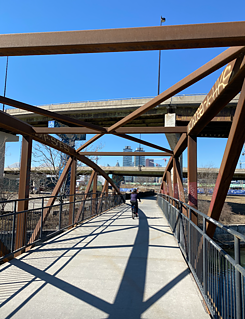Earth Day 2021
Heidelberg in Motion
By Douglas Bell
Heidelberg is a city that invites movement. Though the stone of the University and the mighty Schloss that dominates the town, both going on 800 years, seem immovable, everywhere there is evidence of a city in motion.
Bike riders move seamlessly and continuously throughout the Necker Rhine region from groomed, densely forested mountain trails to distinct and divided paved bike lanes more or less directly on to mass transit where space is set aside for ready storage on the train, tram or bus.
In this respect, Heidelberg’s civic ambition isn’t merely to afford alternative transit but to eschew motorized vehicular traffic altogether and thereby evolve a cityscape free of the anxiety and despoliation we associate with the car. Moreover, the connections between recreation and commute are more or less continuous. Forested mountain trails connect to commuter routes marked by clear logical signage at nodal points throughout the Neckar valley region.
Lessons for Toronto
 © Goethe-Institut Toronto
I was born and raised in Toronto during the 1960s. Cars were it. Public transit, was, at best, second best. Biking and walking were merely recreational and somehow adolescent. Cars were fast and sexy and better. But over time the cost of the car, certainly from an environmental perspective, grew more and more prohibitive. And so walking, biking and mass transit became the new “better way”.
© Goethe-Institut Toronto
I was born and raised in Toronto during the 1960s. Cars were it. Public transit, was, at best, second best. Biking and walking were merely recreational and somehow adolescent. Cars were fast and sexy and better. But over time the cost of the car, certainly from an environmental perspective, grew more and more prohibitive. And so walking, biking and mass transit became the new “better way”. Toronto’s transition, while evident, is still awkward. Debates carry on between alternative transit advocates and those concerned to mitigate “the war on the car”. Compromise, delay and outright regression lead to a disjointed transit system that despite increasingly better commitments result in less than optimal systemic design and implementation. In Toronto, commuters compete on main arteries for space and right of way and struggle to transfer bikes onto trains and busses via stairs, escalators and elevators. Moreover, bikes are too often treated as “weekend transit” and afforded fair weather routes -- elegant though they may be -- to nowhere; the Humber river byways come most especially to mind. If these trails happen to converge with mass transit, happy days. But it’s hardly a design feature, and only tangentially related to anything like an efficient commute.
VIEWS FROM THE TRAIL
One day in late fall I wended my way along a trail up through the campus of a nearby medical centre. At one stage I stopped on some stairs and spied through the trees a woman in full surgical-protective gear standing on a concrete platform just outside a side door to the hospital. She was alone and pounding out texts on her cellular phone. I moved on up to the forest trail fifty yards on and wandered ever upwards noting the evolving infrastructure along the trails, stone direction markers dating back to the 19th century, a stone hutch where a hiker might seek refuge from a winter storm, more modern temporary shelters and hiking infrastructure. The trails cut into the slopes almost to the peaks which reach beyond 500 meters. The lookouts are extraordinary, overseeing the Rhine plain and the French alps further off.The Future: A Literate Transit System?
Every couple of weeks, parked on the street four doors down from our own, a “bücherbus” library makes a weekly stop in front of a Lutheran daycare. We gather, appropriately spaced and masked, along a quiet street waiting politely to enter the narrow book lined interior. The idea of a bus ferrying physical books from place to place might seem eccentric, even antique. But in a time marked by the digitized, atomized commodification of everything, this venture, bridging literacy and transit, seemed to point –like so much else in Heidelberg -- towards a better idea of the future.AUTHOR
Douglas Bell Wrote for and acted in the CBC TV satire "The Newsroom" and co-wrote the screenplay for the Film "Afghan Luke". Prior to that he was correspondent for "The Irish Times", "The Globe and Mail", and "Toronto Life".






